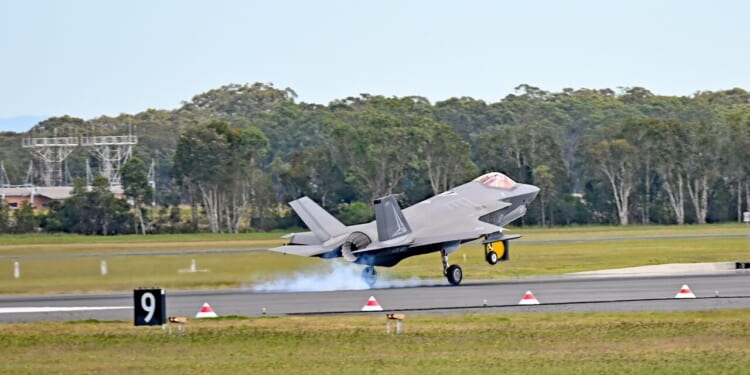If Washington wants to preserve air superiority in an era of ubiquitous sensors and long-range fires, it should stop treating a single platform as a silver bullet.
The F-35 program has long been the poster child for procurement hubris: a seductive promise of one airframe to do it all, funded by generations of taxpayers and defended in Pentagon briefings as the indispensable wrench in the US military’s toolkit.
Today, that story is fraying. Allies are signaling hesitation; economic and schedule realities are drifting farther from the original pitch. In that light, Secretary of Defense Pete Hegseth should take on the ghost of one of his predecessors, Secretary Donald Rumsfeld, by asking bluntly whether the taxpayers should continue buying fifth-generation fighters in the quantities once imagined, or to halt the buy and redirect money to scalable, survivable systems that fit 21st-century combat.
Everyone Knows the F-35 Is Too Expensive
In recent weeks, Spain and India have shelved plans to buy F-35s, a reminder that US allies are reassessing the calculus of very expensive, single-platform dependence. Canada, Switzerland, and Portugal are all also on the fence.
The program’s technical modernization, the Block 4 software and hardware upgrades, has been slower and costlier, a recurring theme Government Accountability Office (GAO) auditors have documented. The Block 4 effort is now years behind and billions of dollars over budget, disrupting not only timelines but the affordability of the entire program. Those slips are not mere program noise. They materially undercut the F-35’s promise to deliver a reliably modern capability at scale.
At the same time, the aggregated price of the program is staggering. The Pentagon’s own acquisition accounting shows program lifetime costs measuring over $2 trillion; auditors and analysts keep upping their estimates of the lifetime bill as delays and tech churns stack up. When a single weapons program consumes a disproportionate share of acquisition dollars, it starves other innovations, forcing a false trade-off between fewer capabilities of many types, or many aircraft of one expensive type.
That fiscal and schedule reality intersects with an operational one: modern high-intensity conflicts are already demonstrating that mass and attritability matter. Peer and near-peer adversaries are fielding sophisticated air defenses and electronic warfare that make a small number of exquisite, expensive platforms a brittle hedge. Ukraine’s playbook of rapidly producing unmanned systems and using swarm tactics has proven operationally decisive in many contexts, offers a cautionary tale for those who equate cost with strategic advantage.
For the Trump administration, which campaigned on restoring American strength while trimming waste, there is a clear policy choice: double down on an increasingly risky, costly platform, or reallocate procurement to systems that offer mass, tempo, and resilience. The moral of modern warfare is not that exquisite platforms are useless—far from it!—but that they must find a place within a force structure that accepts loss, adapts quickly, and overwhelms rivals with numbers and networks. Buying fewer F-35s, and investing the savings in unmanned aerial systems (UAS), loitering munitions, and the logistics, training and autonomy software that multiplies their effects, would be a reform-minded, battlefield-realistic pivot.
What Could the Pentagon Buy Instead of More F-35s?
How big could that pivot be, in practical terms? Let us run a thought experiment on what we could do if we cancelled 500 F-35 purchases over the next 10 years. Assuming a cost of $82 million per jet, this would save $41 billion on procurement. With yearly sustainment costs of around $12.5 million per jet—assuming 50 fewer jets to maintain per year—we would save 2750 years of sustainment costs, or over $34 billion over a decade. This is crucial, because while the procurement savings can only be spent once, the sustainment savings will provide funding for decades to come. Altogether, over ten years, this amounts to nearly $75 billion that could be repurposed to buy drones and enable the industrial surge needed to mass-produce them.
The opportunity cost of this move, of course, is 500 fifth-generation aircraft. But what could $75 billion buy instead?
- XQ-58A Valkyrie (Kratos, US): Public reporting cites potential unit costs as low as a few million if production scales. Kratos and various reports put practical unit prices in the range $4–9 million depending on production scale. Using $6M as a conservative assumption, $75 billion buys ~12,500 Valkyrie drones.
- MQ-28 “Ghost Bat” / Loyal Wingman (Boeing Australia, allied collaboration): Reporting on recent investment and development puts per-airframe estimates in the $8–25M range, depending on configuration; using a conservative mid estimate of $22M, $75 billion buys ~3,400 Ghost Bats (a very large loyal-wingman fleet for allied operations).
- Eurodrone (Airbus/Dassault/Leonardo consortium): Program reporting and European press show full system costs (airframe + ground segment) toward €100M+ (~$110M) per system. At $110M each, $75 billion buys ~680 Eurodrones, enough to equip a major allied MALE/LEO enterprise across NATO.
- Miscellaneous attritable small-drone families: Public reporting indicate DoD intends to field thousands of low-cost attritable drones at budgets measured in the low-hundreds of millions per year. Unit prices are expected in the low-single-digit million range. Using $2M per attritable-class unit, $75 billion buys ~35,000 small-class drones (a saturating force).
- Collaborative Combat Aircraft (CCA): The CCA is the Air Force’s deliberate program to develop “loyal wingman” attritable combat aircraft that operate collaboratively with crewed platforms. The program is a concept-to-field initiative with prices in the $25-30 million range. Assuming $27.5 million per unit, $75 billion could buy ~2,700 CCAs.
The point of this is not literal arithmetic, as policy but proportionality: modest cancellations of an oversized, over-cost program quickly translates into transformative quantities of affordable systems that shape battlespace control. If Washington wants to preserve air superiority in an era of ubiquitous sensors and long-range fires, it should stop treating a single platform as a silver bullet. The path forward is clear: cancel the marginal F-35 buys, accelerate production lines that can be affordably scaled, and buy the drones, sensors, and networks that will win the fights America will actually fight.
That is sober realism, not defeatism. It is a reform program that places operational effectiveness over programmatic vanity, exactly the kind of hard-headed choice the American people deserve.
About the Author: John Ferrari
Maj. Gen. John G. Ferrari is a nonresident senior fellow at the American Enterprise Institute. Over his 32-year US Army career, Ferrari, who is now retired, served as the director of program analysis and evaluation, the commanding general of the White Sands Missile Range, and a deputy commander for programs at the NATO Training Mission in Afghanistan. He has an MBA in finance and strategic management from the Wharton School at the University of Pennsylvania, an MA in national resource strategy and policy from the Industrial College of the Armed Forces (now called the Eisenhower School for National Security and Resource Strategy), and a BS in computer science from the United States Military Academy at West Point.
Image: Shutterstock / Douglas Cliff.


















